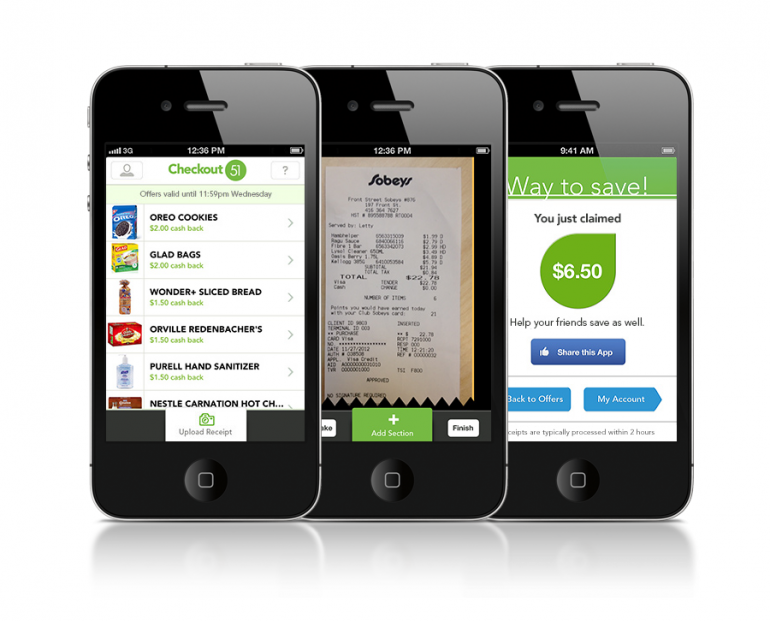While mobile apps from companies including SnipSnap, CouponCabin, and RetailMeNot are tackling on-the-go deals, coupon apps typically require the involvement of grocery stores and other retailers, letting consumers upload their digital and paper receipts or find coupons in the app, scanning them on their smartphone at the point of sale. Toronto-based Checkout 51 wants to give brands a direct channel to consumers, and it launched its mobile coupon app for iOS this week to help consumers get cash back on grocery purchases. The company held a beta period with almost 1,000 users this summer, and during that time members saved over $10,000 on products.
The company, founded by former Gigpark founders Pema Hegan and Noah Godfrey, as well as technical co-founder Andrew McGrath, provides cash back offers that shoppers can redeem after they shop by snapping a photo of their receipt. By working directly with brands to offer deals, it means that retailers don’t have to process coupons, and that shoppers can redeem deals from purchases in any grocery store or retailer in Canada (with a U.S. launch planned in future). It also means consumers don’t have to snap a photo of coupons to add to mobile apps like SnipSnap, or download and print coupons from online deals sites like Retailmenot.
Godfrey said in an interview they’re trying to eliminate the friction involved with finding and redeeming coupons, and the timely process of redeeming multiple coupons at the checkout. “It’s just an archaic experience for a shopper, and it’s even worse on the brand side,” he said, adding that brands have to design coupons, print them, distribute them via mail or in-store displays, and then collect the redeemed coupons and count them to pay out retailers. “For consumers, we wanted to make the whole thing easy. All you have to do is take a photo of your receipt, that’s it…for brands, they can set an offer budget, so when it runs out it runs out so they know exactly what they’re going to spend.”
After downloading the app, consumers can browse through deals and see the cash back available on each purchase, for example $2 cash back on Ruffles chips, or $1.50 cash back on Triscuit crackers (a sample of this week’s deals). A new set of deals is released every Thursday, and each offer can only be redeemed once per member per week. To redeem deals consumers buy the items in store like they normally would, the take a photo of their receipt using their smartphone, and indicate which promoted products they purchased. Checkout 51 verifies that the purchases were indeed made, and then credits the user’s account with the cash back, mailing a check every time they hit $20, with plans to add PayPal and other payout methods.
“We don’t have to talk to retailers at all,” Godfrey said. “One big difference from a business perspective about Checkout 51 from a lot of other mobile coupon products out there is that we require no integration with the retailer at the point of sale.”
Brands set a budget for every offer, and can access a dashboard with analytics on who is buying their products, where they’re purchasing them, and other data. Personalization is also a big part of brand campaigns, so a consumer packaged good company could only target shoppers who shop at a specific store, have purchased a specific product in the past, or who tend to buy a category of products, like organic goods. Since customer data is anonymous, brands can’t reach out to users with additional offers or deals. In terms of pricing, the company charges a fee per redeemed coupon, with distribution and processing included in that fee.
The company plans to add geo-fencing to the app so consumers are notified about coupons when they’re in store (right now they get push notifications and emails about new weekly deals), similar to how Apple’s Passbook app notifies users of tickets, coupons and other promotions when they’re near that location. They’re also working on an Android app, and Godfrey said they plan to stay mobile-only.
Like with other mobile coupon apps, what Checkout 51 offers in convenience it lacks in distribution. Right now only iPhone users who have downloaded the app will get access to the deals, and since it cuts retailers out of the equation, there isn’t the opportunity to market the coupons on the shelf, in flyers, or via direct mail (unless a brand wanted to advertise the app themselves on their own product packaging and print marketing materials). Godfrey said they’ll work to partner with deal forums and websites to get the word out, and he anticipates that brands will push deals out online. Many brands have their own mobile apps where they can promote deals, but for those looking for additional exposure to smartphone users who might not want to download a separate app for every brand, it could be a good way to take coupon habits from the point-of-sale to post-purchase.


